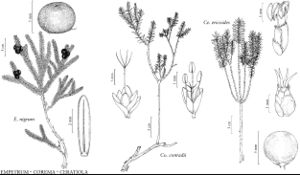Corema
Edinburgh New Philos. J. 2: 63. 1826 ,.
Subshrubs or shrubs, (aromatic). Stems erect, (branches ascending); old twigs rough with persistent leaf-bases, young twigs hairy. Leaves persistent, opposite or whorled; petiole present; blade coriaceous, margins entire. Inflorescences terminal capitula (on current-year’s growth), 3–7 [–9] -flowered; perulae absent. Flowers unisexual (dioecious), radially symmetric; sepals 4–5, distinct; petals absent [3–4, distinct]; stamens [2–] 3–4, exserted; anthers without awns, longitudinally dehiscent; ovary 3–5-locular; style exserted; stigma linear. Fruits drupaceous, [white to pink] (gray), globose, dry [fleshy]. Seeds (pyrenes) 3–5, planoconvex, not winged, not tailed; testa smooth. x = 13.
Distribution
e North America, sw Europe, Atlantic Islands (Azores)
Discussion
Tuckermania Klotzsch
Species 2 (1 in the flora).
Corema was traditionally included in Empetraceae; phylogenetic studies based on morphological and molecular characters (A. A. Anderberg 1994c; K. A. Kron et al. 2002; Li J. H. et al. 2002) indicate that Empetraceae are nested within a monophyletic Ericaceae and that Ceratiola + Corema are in a lineage distinct from Empetrum. Previous authors recommended its inclusion within the Ericaceae based on comparative morphology and embryology (C. E. Wood Jr. and R. B. Channell 1959). Corema differs from Empetrum and Ceratiola by lacking petals and in having fewer seeds per fruit than Empetrum (six to nine), but more than Ceratiola (two). The capitate, terminal inflorescences (condensed racemes) of Corema differ from the axillary, solitary flowers of Empetrum and the axillary, three- to four-flowered, cymose clusters of Ceratiola. The genus has an amphi-Atlantic distribution; Corema album (Linnaeus) D. Don occurs in the Iberian peninsula and the Azores.
Selected References
None.
